Glazing
By the end of this unit each apprentice will be able to:
Key Learning Points:
Windscreen – Numerical Order of Removal
Cutting Wire Method
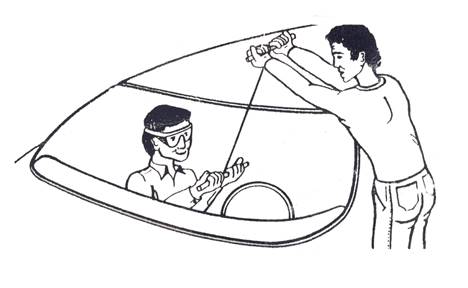 From inside the vehicle push one end of cutting wire through screen sealer approximately 10cm down from either top corner. Tie off outside wire end to a ‘T’ handle and inside wire end to a wire spike tool. Aided by a second person carefully cut around the screen to remove.
From inside the vehicle push one end of cutting wire through screen sealer approximately 10cm down from either top corner. Tie off outside wire end to a ‘T’ handle and inside wire end to a wire spike tool. Aided by a second person carefully cut around the screen to remove.Figure 1: Cutting Wire Method
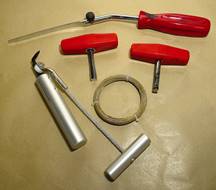
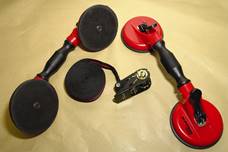
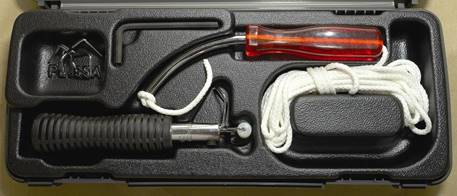
Piano/Cheese Wire Air Removal Tool
Cord Removal Kit
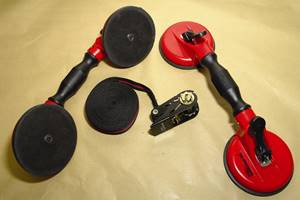
Suction Pads
Indirect glazed windscreen removal and replacement
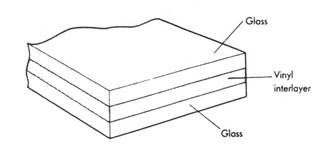 The two basic types of safety glass used in the car windscreen are laminated and toughened. Laminated glass is of a sandwich construction and consists of two pieces of thin glass one on either side of and firmly united to a piece of transparent reinforcing known as the interlayer (figure 2). Although such a glass may crack forming a spider web pattern it holds together and the panel remains in one piece except under conditions of the most violent impact. Toughened glass is produced by process of heating a solid piece of glass and then rapidly cooling it so that its liability to fracture is greatly reduced and its strength increased to about six times that of untreated glass. If fracture should take place the resulting fragments consist of very small comparatively harmless particles (Figure 3).
The two basic types of safety glass used in the car windscreen are laminated and toughened. Laminated glass is of a sandwich construction and consists of two pieces of thin glass one on either side of and firmly united to a piece of transparent reinforcing known as the interlayer (figure 2). Although such a glass may crack forming a spider web pattern it holds together and the panel remains in one piece except under conditions of the most violent impact. Toughened glass is produced by process of heating a solid piece of glass and then rapidly cooling it so that its liability to fracture is greatly reduced and its strength increased to about six times that of untreated glass. If fracture should take place the resulting fragments consist of very small comparatively harmless particles (Figure 3).
Figure 2: Laminated Glass
In major accident damage removal and replacement of the windscreen is an essential feature of the repair. Many windscreens and rear windows are held in place by a rubber weather strip which is usually of single piece construction. Both glass and any outside trim mouldings if used are recessed into the weather strip. It also has a recess which fits over the body flanges all round the opening for the glass. It is this portion of the weather strip that holds the entire assembly in place.
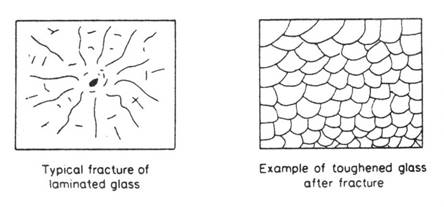
Figure 3: Characteristic Breaking Pattern of Laminated and Toughened Glass
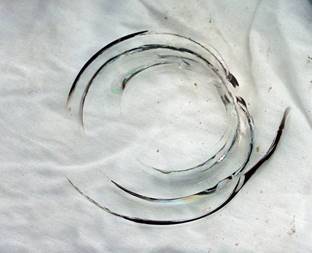
Laminated Glass when Broken
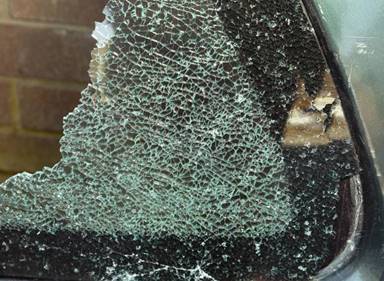
Toughened Glass when Broken
Indirect types of glazing systems can be identified for each specific model by referring to the body section of the relevant manufactures repair manual. The rubber weather seals used are mastic sealed, dry glazed, self sealing or push fit (figure 4). The self sealing types are held in place by a removable centre filler strip and can be mastic sealed or dry glazed (Figure 4c). All the systems are used with either a rubber weather strip moulding with a sealing compound (Figure 4a) or a rubber weather strip moulding without a sealing compound (Figure 4b). The rubber weather strip has two rebates one for glass and one to seat over the metal flange of the body aperture. It is the contact area of the aperture that requires careful attention whenever the glazing is disturbed or removed. In all cases it is essential that the aperture is correctly painted prior to refitting any of the weather seals.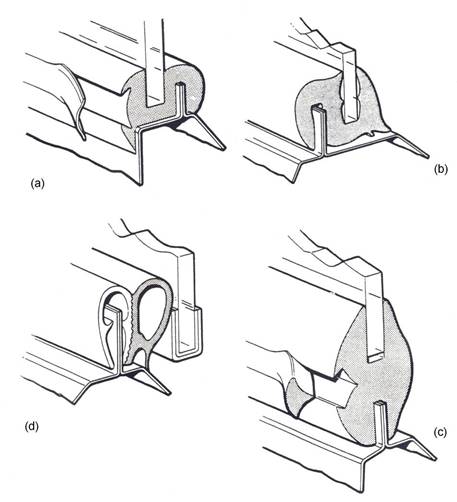
Figure 4: Indirect Glazing System
(a) Mastic sealed (b) Dry glazed (c) Self-sealing (d) Push fit
In order to remove a windscreen which is fitted with self tensioning weather strip the following procedure must be carried out. First cover the bonnet to protect the paintwork. Then working from the inside of the car, remove any instrument panel mouldings or trim which may interfere with the removal of the windscreen. Also working from the outside of the vehicle, remove any windscreen chrome mouldings which may be fitted into the weather strip. Again working from the inside and starting from one of the top corners pry the rubber weather strip off the body flange with a screwdriver. At the same time press firmly against the glass with your hand adjacent to the portion of the rubber lip being removed or bump the glass with the palm of the hand; this should force the entire assembly over the body flange. The windscreen can then be removed from the body opening.
To replace the windscreen first clean the glass channel in the rubber weather strip to be sure that all traces of sealer and any broken glass are removed. Place a bead of new sealing compound all round the weather strip in the glass channel. Work the glass into the glass channel of the weather strip and be sure it is properly seated all the way round. Lay the windscreen on a bench suitably covered to prevent scratching so that the curved ends are pointing upwards and in this position the pull cords used to seat the rubber lip over the body flange can be inserted into the metal channel on the weather strip (Figure 5). One or two cords may be used. Where two cords are normally used they can be pulled in opposite directions which will make the fitting of the windscreen easier. Commence with one cord from the bottom right hand side of the windscreen, leaving about one foot spare for pulling. Start the second cord from the bottom let hand corner and proceed to the right following round up to the top left hand corner. Apply sealer all round the metal lip on the body aperture. Place the entire unit in the windscreen opening with the cord ends hanging inside the vehicle. An assistant can help by pressing against the glass from the outside while each cord is pulled out of the groove. As the cord is pulled out the rubber lip is seated firmly over the body flange. A rubber mallet can be used to tap the unit around the outside so as to seat the entire windscreen assembly firmly in place. Any surplus sealer can be cleaned off with white spirit.
The procedure for removing a windscreen fitted with self sealing weather strip is first to locate the joint in the filler strip which runs right through the centre of the weather strip. The strip is then carefully eased up and pulled out slowly around entire assembly.
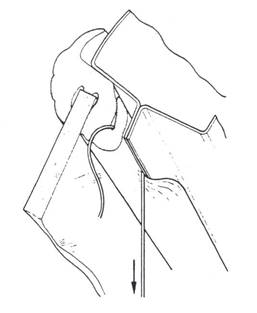 Figure 5: Using Pull Cords to Fit Windscreens
Figure 5: Using Pull Cords to Fit Windscreens
This relieves the tension on the glass which can then be lifted out of the weather strip by easing one corner first. To replace this type of windscreen the metal lip on the body aperture is sealed with a sealer the appropriate channel in the weather strip is then placed over this lip and seated all the way round the body aperture. The windscreen is fitted into the glass channel on the weather strip with the aid of a special tool which enables the glass channel lip to be lifted thus allowing the glass to slip easily into position. A small brush is needed to apply a solution of soap and water to the filler channel. This assists the filler strip installation. A specially designed tool is used to insert the filler strip into its channel.
Indirect Glazing Removal/Replace Kit
4.0 Safe Removal and Refit of a Direct Glazed Windscreen
4.1 Direct Glazing Bonding Techniques
The method of direct glazing of windscreens also known as bonding is very popular with motor manufacturers. This process involves the bonding of glass into the aperture. Some of the advantages claimed for direct glazing are as follows:
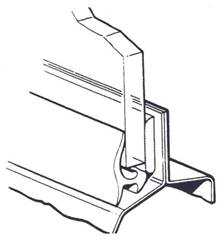 Various bonding materials are used in direct glazing. Some require heating to induce a chemical reaction to create adhesion whilst others will cure at room temperature. Polyurethane and silicone materials are usually supplied as a pumpable tape. They are cold cured and the material is dispensed on to the glass through a specially formed nozzle out on the end of a cartridge. This can be done with the aid of a hand operated or compressed air cartridge gun. These materials are highly viscous in their uncured state enabling a high degree of maneuverability within the glass aperture to ensure a good seal.
Various bonding materials are used in direct glazing. Some require heating to induce a chemical reaction to create adhesion whilst others will cure at room temperature. Polyurethane and silicone materials are usually supplied as a pumpable tape. They are cold cured and the material is dispensed on to the glass through a specially formed nozzle out on the end of a cartridge. This can be done with the aid of a hand operated or compressed air cartridge gun. These materials are highly viscous in their uncured state enabling a high degree of maneuverability within the glass aperture to ensure a good seal.
Figure 6: Direct Glazing with Moisture-cured Polyurethane
The sealant itself is either one or two component polyurethane. The latter contains an accelerator compatible with the adhesive this is applied evenly to the perimeter of the windscreen (figure 6). Once this is achieved the glass is placed into the aperture using glass suckers and aligned before securing.
When a one component polyurethane is used the car can be driven away in four to six hours: if a two component polyurethane is used it takes only 30 minutes to cure, allowing the vehicle to be back on the road within an hour of the repair starting.
To remove the glass from the vehicle the bonding material has to be cut. This can be achieved by using piano wire, a special cutter or a hot knife, as follows:
Piano wire
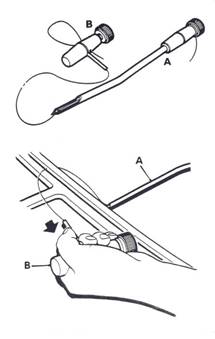 Before using this method of removal there are certain safety precautions that should be observed. Gloves should be worn to protect the hands and safety glasses or goggles should be used for eye protection in the event of the wire or glass breaking. When the finishers or mouldings have been removed to expose the bonded area of the glass the wire has to be fed through the bonding. This is done by piercing a hole through the bonding and feeding the wire through with the aid of pliers. Handles can be fixed to the ends of the wire to allow a pulling action (Figure 7).
Before using this method of removal there are certain safety precautions that should be observed. Gloves should be worn to protect the hands and safety glasses or goggles should be used for eye protection in the event of the wire or glass breaking. When the finishers or mouldings have been removed to expose the bonded area of the glass the wire has to be fed through the bonding. This is done by piercing a hole through the bonding and feeding the wire through with the aid of pliers. Handles can be fixed to the ends of the wire to allow a pulling action (Figure 7).
Figure 7: Removing Direct Glazing using a Piano Wire
Pneumatic or electric cutter (oscillating)
This is an air or electric powered tool to which special shaped blades to suit specific vehicle models are fitted. The tool removes windscreens that have been bonded with polyurethane adhesives.
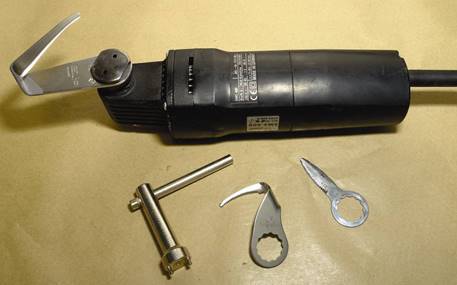
Electric Windscreen Cutter
Hot knife
The hot knife can be used by one person cutting from the outside of the vehicle. It can cut round the average bonded windscreen and clean off the excess remaining adhesive while minimizing the risk of damaging the car bodywork. Before use, all trim around the windscreen both inside and outside should be removed. The cutting medium is provided by a heated blade which is placed under the edge of the glass and pulled around the perimeter melting the bonding to release the windscreen. It is used in conjunction with an air supply which constantly blows on to the cutting area of the blade. This prevents the heat dissipating along the blade and gives a constant temperature as well as eliminating smoke and fumes emitted from the cutting operation. Overheating can result in toxic fumes being given off and a charcoal filter mask should be worn as a safety precaution.
Before glazing can be replaced the bonding surfaces must be prepared correctly. The residue of the original sealer left in the aperture has to be trimmed to ensure there is a smooth layer for the new sealer to adhere to and to allow the glass to seat in the correct position. Various sealants for windscreen replacements are available.
The surfaces are then prepared with the materials included in the individual manufacturers glass replacement kit that is sealer application gun with bonding material, suction cups and leak test equipment and following the instructions provided. There is little variation in the sequence of operations which is typically as follows:
4.2 Instructions
Please read carefully
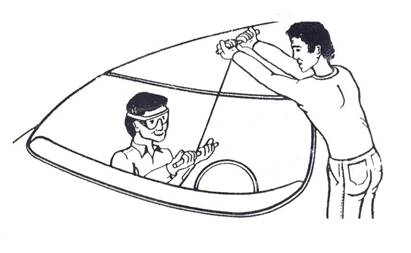
When working with solvents and primers use PVC gloves or apply barrier cream to hands.
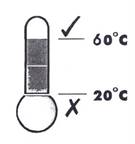

Figure 8
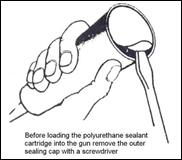
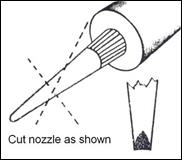
Figure 9: Installing the Polyurethane Cartridge into the Gun
Sealer and Sealer Gun
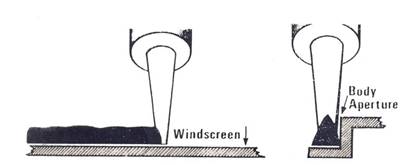
Figure 10: Applying Sealant
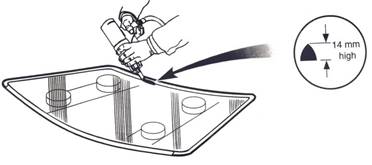 Figure 11: Applying Sealant to Windscreen
Figure 11: Applying Sealant to Windscreen
Caution: If a leak or leaks are detected apply sealer to the area and retest. Do not remove the screen and attempt to spread the sealer already applied.
Caution: Do not slam the vehicles doors with the windows fully closed until the screen is fully cured.
 The integrity of the vehicles safety features can be impaired if incorrect windscreen replacement bonding materials and fitting instructions are used. The manufacturer’s instructions should be adhered to.
The integrity of the vehicles safety features can be impaired if incorrect windscreen replacement bonding materials and fitting instructions are used. The manufacturer’s instructions should be adhered to.
5.0 Cure and Drive-Away-Time
AUTOBOND ZR 400 is the fastest one part moisture curing polyurethane sealant on the world market. The sealant cures at the rate of 6mm per 24 hours provided the temperature is at least 20ºC with 65% relative humidity. Because less sealant is used with the “short cut out methods”, cure and drive-away time is reduced. We therefore recommend the following:
Summer
In the summer time the vehicle can be returned to normal service one hour after front windscreen replacement. We recommend a 2 hour drive-away- time for rear windscreens and side lights.
Winter
In winter conditions the vehicle can be returned to normal service after front windscreen replacement. We recommend a 4 hour drive-away time for rear windscreens and side lights. Cure time and performance of all polyurethane sealants is affected should the temperature drop to below +5ºC. In these conditions it is advisable to keep the vehicle indoors for longer and/or use the vehicle heater and blower to accelerate cure time. If in any doubt please contact our Technical Department who will be pleased to offer practical advice and further assistance if required.
6.0 Airbag
 See instruction on product for drive-away time for windscreen replacement on vehicles with airbags.
See instruction on product for drive-away time for windscreen replacement on vehicles with airbags.
Figure 12: Glass Trolley
7.0 Inspect and Carry out Leak Testing on Fitted Windscreen
7.1 Leak detection methods
The general principles for searching for the actual location of where water leaks could potentially occur on the vehicle are not specific to any particular model and can apply to all vehicles.
First start by obtaining as much information as possible from the customer as to when, where and how the leak occurs and also whether the water appears to be clean or dirty. If these facts are not known, considerable time could be spent checking the wrong areas of the vehicle.
Tools and equipment
The following tools and equipment are recommended:
Locating the leak
Locating the source of the water leak involves a logical approach together with a combination of skill and experience. For the purpose of locating the leak the vehicle should be considered in three specific areas: the front interior space, the rear passenger space and the boot space. From the information provided by the customer the body repairer should be able to determine which area is the right one on which to concentrate. Having identified the area of the leak, the repairer must find the actual point where the water is entering the vehicle. An ordinary garden spray of type which can be pressurized and adjusted to deliver water in the form of a very fine spray or a small powerful jet has been found to be very effective in helping to locate most leaks. Using a mirror and torch will help to see into any dark corners.
Testing
The sequence of testing is particularly important. Always start at the lowest point and work upwards. The reason for this is to avoid masking a leak in one place while testing in another. If for example testing was to commence around the windscreen water cascading down could leak into the car via the heater plenum or a bulkhead grommet. However it could be wrongly assumed that the windscreen seal was at fault.
The visible examination of door aperture seals, grommets and weather strips for damage, deterioration or misalignment as well as the actual shut of the door against the seals are important parts of identifying an area where water can pass through.
Leak detection using ultrasonic equipment
When the vehicle is in motion the body shape may produce eddy currents and turbulence which can force air and water through the smallest orifice. When the vehicle is stationary it can be difficult to reproduce these conditions to a realistic level.
The ultrasonic equipment works on the principle of a transmitter creating ultrasonic waves which penetrate the smallest orifice in the vehicle body and are then picked up by a receiver fitted with a suitable probe which can in turn pinpoint the exact leak point. The transmitter is placed in a base plate which automatically switches it on via a reed switch in the base of the transmitting body. Ultrasonic waves will then penetrate out through the unsealed area, including the front windscreen, wiper spindle and washer jet fitment, roof seams bulkhead seams and grommets, A-post area, door seals, front wheel arch seams and heater air intakes to the receiver.
An important feature of this equipment is the incorporation of a sensitivity control which enables the operator to check a wide range of fitments. For example a boot seal is a very light touch seal whereas a urethane screen fitment is at the other end of the scale setting of the equipment and would need a high setting to determine a leak.
To ensure satisfactory leak location and testing it is recommended not to use a leak detector on a wet vehicle which should be blown prior to the test. As with any equipment it is important to read the instructions to enable the equipment to be used to its full potential.
Sealing
Having located the point of the water it is then necessary to carry out satisfactory rectification. Door aperture seals and weather strips should be renewed if damaged or suffering from deterioration. Alternatively the seals can be adjusted by carefully setting the mounting flange after making sure the fit of the door is correct.
Leaks through body seams should be sealed from the outside wherever possible to ensure water is excluded from the seam. First dry out with compressed air or a hot air blower.
When leaks occur between the glass and the body, avoid removing the glass if possible. Use recommended sealers to seal between the glass and the weather strip or the body.
If the vehicle is wet then it should be blown dry prior to sealing. It is difficult to seal a wet vehicle because if a fault is found it cannot be rectified quickly before moving to another area.
7.2 Windscreen repair: Glass Weld Pro-Vac
This system of repair involves extracting all the air from the damaged glass and replacing the void with a resin which when cured with ultraviolet light, is optically clear and is stronger than the glass that has been replaced. The system is widely accepted and repair to Glass Weld standard would not cause the vehicle to fail the statutory Department of Transport test for windscreen: 80 per cent of stone damaged windscreens can be repaired by this method.
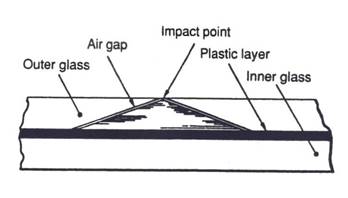
Figure 13: Damaged Windscreen (Laminated Safety Glass)
When glass breaks an air gap opens up. Sometimes crushed glass may also be present inside the glass on either side of the air gap. These three things result in the visibility of the damaged area being affected. The damage will eventually spread further as the 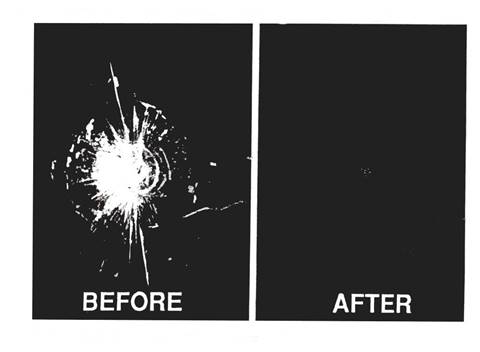 temperature changes and the vehicle flexes in normal use.
temperature changes and the vehicle flexes in normal use.
Figure 14: Before and After Repair
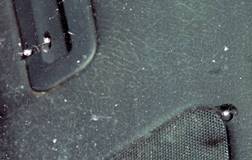
Before Repair
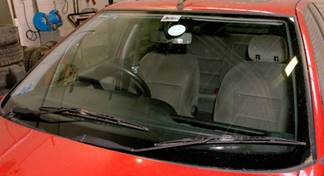
After Repair
7.3 Repairing Chips in Laminated Glass
The System Works, as follows:
Red crack fill = Can repair cracks 5cm long
Green polymer 2 = Can repair chips 5mm diameter
Instructions:
Wurth Glass Repair Kit
Summary
Safety is of utmost importance when glazing because of breaking glass and the possibility of flying piano wire both of these could cause serious injury in the form of cuts and glass getting into eyes, so always wear P.P.E Equipment. Do not take any chances!
Glazing is a vital aspect of vehicle body repair and the correct replace repair procedures are very important because in the event of an accident if a person is not wearing a safety belt the glazing may restrain them in the vehicle, this is not the ideal situation but it may save a life.
Source: http://local.ecollege.ie/Content/APPRENTICE/liu/vbr_notes/module4/m4u2.doc
Web site to visit: http://local.ecollege.ie
Author of the text: indicated on the source document of the above text
If you are the author of the text above and you not agree to share your knowledge for teaching, research, scholarship (for fair use as indicated in the United States copyrigh low) please send us an e-mail and we will remove your text quickly. Fair use is a limitation and exception to the exclusive right granted by copyright law to the author of a creative work. In United States copyright law, fair use is a doctrine that permits limited use of copyrighted material without acquiring permission from the rights holders. Examples of fair use include commentary, search engines, criticism, news reporting, research, teaching, library archiving and scholarship. It provides for the legal, unlicensed citation or incorporation of copyrighted material in another author's work under a four-factor balancing test. (source: http://en.wikipedia.org/wiki/Fair_use)
The information of medicine and health contained in the site are of a general nature and purpose which is purely informative and for this reason may not replace in any case, the council of a doctor or a qualified entity legally to the profession.
The texts are the property of their respective authors and we thank them for giving us the opportunity to share for free to students, teachers and users of the Web their texts will used only for illustrative educational and scientific purposes only.
All the information in our site are given for nonprofit educational purposes